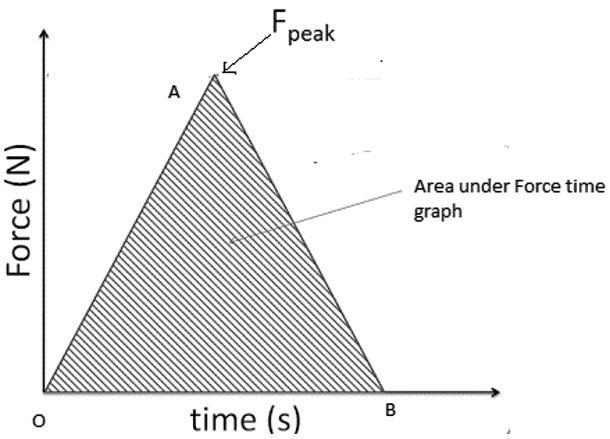
The area under a force time graph gives acceleration.
A. True
B. False
Answer
585.6k+ views
Hint: Area under the force-time graph gives the impulse acting on the body.
Complete step by step solution:
Let us consider a Force time graph shown below with peak of force as \[{F_{peak}}\]. The x-axis Force makes the curve OAB such that a triangle OAB is formed.

If we calculate area of triangle OAB,
Area of shaded portion \[ = {\text{ }}\raise.5ex\hbox{$\scriptstyle 1$}\kern-.1em/
\kern-.15em\lower.25ex\hbox{$\scriptstyle 2$} {\text{ }}Base \times Altitude\]
\[ = \raise.5ex\hbox{$\scriptstyle 1$}\kern-.1em/
\kern-.15em\lower.25ex\hbox{$\scriptstyle 2$} {\text{ }}T \times {F_{peak}} = Formula{\text{ }}of{\text{ }}Impulse = \] Change in momentum of body
Hence, Area under the force-time graph gives the impulse (or change in momentum) acting on the body.
Thus, the above statement that the area under the Force time graph gives acceleration is false.
Additional Information:
1. The dimensional formula of impulse is the same as that of momentum \[\left[ {M{\text{ }}L{\text{ }}{T^{ - 1}}} \right]\]. In SI the unit of impulse is Ns or\[kgm{s^{ - 1}}\].
2. An accelerated motion is always due to a force. The acceleration produced by a force in the motion of a body depends only upon its mass.
Note: Impulse received during an impact is equal to the product of average force during the impact and the time for which the impact lasts and is also equal to the change in momentum produced during the impact.
Complete step by step solution:
Let us consider a Force time graph shown below with peak of force as \[{F_{peak}}\]. The x-axis Force makes the curve OAB such that a triangle OAB is formed.

If we calculate area of triangle OAB,
Area of shaded portion \[ = {\text{ }}\raise.5ex\hbox{$\scriptstyle 1$}\kern-.1em/
\kern-.15em\lower.25ex\hbox{$\scriptstyle 2$} {\text{ }}Base \times Altitude\]
\[ = \raise.5ex\hbox{$\scriptstyle 1$}\kern-.1em/
\kern-.15em\lower.25ex\hbox{$\scriptstyle 2$} {\text{ }}T \times {F_{peak}} = Formula{\text{ }}of{\text{ }}Impulse = \] Change in momentum of body
Hence, Area under the force-time graph gives the impulse (or change in momentum) acting on the body.
Thus, the above statement that the area under the Force time graph gives acceleration is false.
Additional Information:
1. The dimensional formula of impulse is the same as that of momentum \[\left[ {M{\text{ }}L{\text{ }}{T^{ - 1}}} \right]\]. In SI the unit of impulse is Ns or\[kgm{s^{ - 1}}\].
2. An accelerated motion is always due to a force. The acceleration produced by a force in the motion of a body depends only upon its mass.
Note: Impulse received during an impact is equal to the product of average force during the impact and the time for which the impact lasts and is also equal to the change in momentum produced during the impact.
Recently Updated Pages
The number of solutions in x in 02pi for which sqrt class 12 maths CBSE

Write any two methods of preparation of phenol Give class 12 chemistry CBSE

Differentiate between action potential and resting class 12 biology CBSE

Two plane mirrors arranged at right angles to each class 12 physics CBSE

Which of the following molecules is are chiral A I class 12 chemistry CBSE

Name different types of neurons and give one function class 12 biology CBSE

Trending doubts
One Metric ton is equal to kg A 10000 B 1000 C 100 class 11 physics CBSE

Explain zero factorial class 11 maths CBSE

What is 1s 2s 2p 3s 3p class 11 chemistry CBSE

Discuss the various forms of bacteria class 11 biology CBSE

State the laws of reflection of light

Difference Between Prokaryotic Cells and Eukaryotic Cells




